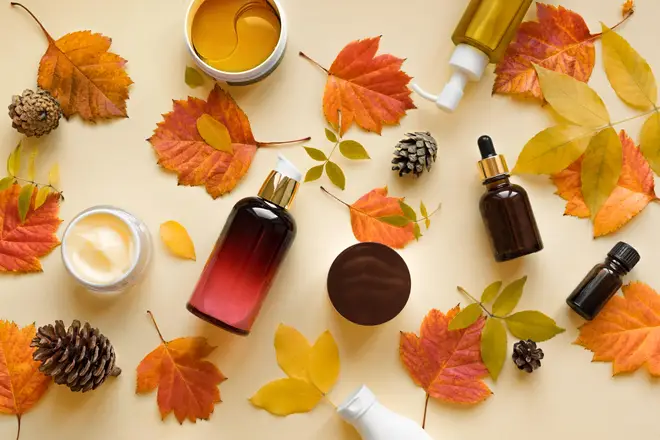Rosacea, dullness and a flaky complexion: How to treat common 'autumn skin' complaints
3 November 2021, 15:32

Three of London's top skin experts share how to keep your face smooth and glowing this autumn, whether you are looking for products to use at home, or an in-clinic treatment programme
As much as we like to think of autumn as a few cosy months of PSL and boxset binges, it’s also marks the start of skin problem season.
The unholy alliance of less sunlight, more central heating, plus wet and cold weather, is all it takes to get skin - once glowing and lightly freckled from plenty of sunshine - looking rough, red, patchy and sore.
The change in conditions can be enough to trigger dormant problems like rosacea, psoriasis or coldsores, or just cause your skin to look dull and lifeless.
And if you are one of the millions of people whose skin takes a turn for the worst as soon as the clocks have turned back, it can be hard to know where to start.
To help you feel and look your best this autumn, Heart.co.uk asked three of London’s top aesthetic doctors and facialists for the most common skin complaints their clients ask them to help with, and how they do it…
Dr Kaywaan, Hannah London Clinic

What skin complaints tend to flare up in autumn?
The key symptoms of “autumn skin” include dryness, dull and sallow skin tone, sun spots, flaking and irritation as well as the flare-up of some chronic conditions.
Your skin can remain beautiful and glowing, however, if you treat it correctly and make some minor adjustments to your beauty regime to account for the change of seasons.
Which in-clinic treatments would you recommend to treat these concerns?
Rosacea is impaired skin barrier. We need to thicken skin and remove the microbes causing skin irritation. Before a flare happens, using microneedling to stimulate new collagens and protective barrier.
Azeliac peel can help calm a mild flare up, but severe flare ups may need light therapy, laser and topicals.
What home products can help skin as the weather changes?
Home care, Alumier SPF sheer hydration and moisturiser, HydraDew which is an intensely rich formula that moisturises, nourishes and improves skin texture using soothing and moisturising ingredients like sodium hyaluronate, shea butter, aloe, and niacinamide.
Powerhouse peptides firm and strengthen the skin, reducing the appearance of fine lines and wrinkles, while antioxidants provide protection from free radical damage.
Claire Williams, founder of WOW Facial

What skin complaints tend to flare up in autumn?
As the weather gets colder you are more likely to see a rise in dry inflammatory conditions such as eczema and psoriasis.
With the addition of central heating this can lead to a break down of the skin barrier function leaving skin drier than usual and more irritated.
Which in-clinic treatments would you recommend to treat these concerns?
I would always recommend something personalised. Everyone's skin is different. WOW Facial is a hyper personalised system where the trained practitioners with devise a treatment protocol to suit your skin care needs.
Autumn is known as peel season in aesthetics and beauty so a good skin peel that can slough off dead skin and rebuild your skin barrier function and improve the softness, hydration and smoothness of the skin is ideal for this time of year.
WOW facial do a glow peel that can add the zing back to your skin.
What home products can help skin as the weather changes?
I always recommend a good hyaluronic acid based serum and if you can get one with a good 20% vitamin C this will really brighten up your skin. An SPF is still essential at this time of year. Find a multi tasking one like Synergy 6 from Intradermology.
A thermal filter, blue light filter and a pollutant filter on top of SPF 50 coupled with good moisturisers and vitamin C makes a wonderful SPF for use all year round but especially in winter.
What ingredients should we be looking out for?
Really good hydrators like hyaluronic acid, moisturisers like shea butter to help protect the skin barrier, vitamin C is always good, and I love lactic acid to smooth the skin surface and moisturise the skin.

VIVA Skin Clinics explain facial contouring
Dr OBT, founder of Halcyon Aesthetics

What skin complaints tend to flare up in autumn?
It's best to keep skin moisturised, avoid very hot showers, and apply an SPF which has a moisturising ingredient in it (OBT Sunscreen SPF 55 has aloe vera for example to soothe skin), or you can use a peptide rich serum under your sunscreen during the day.
Which in-clinic treatments would you recommend to treat these concerns?
The original Hydrafacial Elite MD therapy, our signature Glow facial and our new Dermadrop Meso-facial which is literally like airbrushing your face with special hydrating ingredients such as hyaluronic acid.
I recommend a combination approach- the Hydrafacial to remove the impurities deep inside the pores, suctioned out gently and then the Dermadrop to deeply hydrate!
What home products can help skin as the weather changes?
Hyaluronic acid moisturisers, serums with antioxidants and peptides, all help to plump up the skin. Retinol or bachuchiol can still be used, either on alternative nights to moisturiser, or as part of the 'sandwich' technique. This is when you put moisturiser first, then retinol and then moisturiser again on top.
This helps to avoid any irritation and provides skin rejuvenation and hydration together!
What ingredients should we be looking out for?
In order for products such as moisturisers (which contain squalane, vitamin E, argan oil, hyaluronic acid or even some oils) to penetrate into the skin and actually make a difference, we should use an exfoliating cleanser with glycolic acid.
AHA/BHA cleansers help exfoliate the outer surface of the skin, which helps the products to be absorbed better! This and in-clinic facial treatments such as Hydrafacial, Dermadrop facial, Fire and Ice resurfacing facial and even some skin peels - when done as advised (every 21-28 days) help make a massive difference.
Anything else to add?
For skin conditions such as rosacea, melasma etc we can always add the appropriate laser/light therapies as part of the regime to further improve skin conditions.
For an added deep hydration to the skin I love using Profhilo! As an 'injectable moisturiser' it gives a healthy glow to the skin of the face, neck, decolletage and hands!
Find out more about Halcyon Aesthetics


































